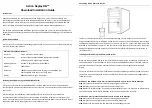
--2--
1
2
3
4
5
Battery Lifetime and Efficiency:
Keep the batteries cool,
LiFePO4
preferably
above 0 °C
.
Choose
an appropriate location for
installation.
Store only fully charged batteries and recharge them periodically.
Open lead-acid batteries and batteries being "maintenance-free according to EN/DIN":
Check the acid level periodically!
Recharge deeply discharged lead batteries
immediately
!
LiFePO4: Only use complete batteries with BMS and safety circuit.
! Deep discharge is to be absolutely avoided !
Installation of the Unit
Install the charger
near the board supply battery to be charged (for short charging cables)
at a clean, level and hard
mounting surface, which is protected from moisture, humidity and aggressive battery gases. The unit can be installed in any
position.
Despite the charger's high efficiency, heat is produced, which is brought out of the casing by means of the built-in fan. The
vent holes at the unit rear should never be covered (minimum distance 10 cm) to ensure full charging capacity. Ensure
sufficient ventilation in the
environment of the unit
so that the heat can be dissipated.
Otherwise, in the event of overheating, the charger will reduce its charging capacity.
Unit Connection
a.
Choose the appropriate connection plan for the application of the unit:
Standard
connection plan, including options,
for all types and power classes, page 3.
Combination with electroblock
"EBL"
, "EVS" with further use of the cabling and fuses of the
customer, which are already existing in the vehicle. Only suitable for VCC 1212-
50
, page 4.
Suitable for combination with electroblock
"EBL"
, "EVS" with the existing cabling of the customer,
however with separate VCC cabling. Suitable for
all VCC types
with full capacity, page 5.
Special case:
In case of a cutoff relay of the customer, which exists in the vehicle and which is in a
very difficult to access location or which is not accessible. Only suitable for VCC 1212-
50
, page 6.
Special case:
In case of temporarily very high consumer current rates, such as with operation of a
body air-conditioner during driving with powerful inverter, page 7.
Option: Usually, the Start IN "
Vs-
and
Vs+
" sensor cables are not required when observing the option notes for
the tables 1, page 8.
Option: Usually, the Board OUT "
Vb-
and
Vb+
" sensor cables are not required when observing the option notes
for the tables 1, page 8.
b.
Implement 3 power connections
observing the
tables 1, page 8
:
"Recommended Cable Cross-Sections, Cable Lengths and +Fuse Capacities".
Reverse battery (+/- are mixed up)
might result in
serious damage
of the unit!
c.
Produce the control connections. See description from
page 9
,
"Configuration of the
9-pole Plug-in Terminal Strip
(Sensor Inputs and Terminal)"
Unit Settings
d.
How to set the charging program "Board" battery (type, design, technology acid, gel, AGM, LiFePO4), from
page 11.
e.
Adjustment of the further settings and functions, setting of the six (6) slide switches, from page 14,
tables 2, 3, 4.
Start-up and Function Test:
f.
Further description, see page 17.
Further operation of the unit is not required during normal automatic mode.



































